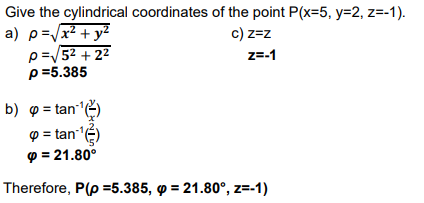ASAP Please write neatly, or it is better if it is encoded. Thank you. BELOW ARE EXAMPLES. PLEASE FOLLOW ITS FORMULA AND STEPS. Express the uniform vector field F = 5ax in a) cylindrical components; b) spherical components.
ASAP Please write neatly, or it is better if it is encoded. Thank you. BELOW ARE EXAMPLES. PLEASE FOLLOW ITS FORMULA AND STEPS. Express the uniform vector field F = 5ax in a) cylindrical components; b) spherical components.
An Introduction to Physical Science
14th Edition
ISBN:9781305079137
Author:James Shipman, Jerry D. Wilson, Charles A. Higgins, Omar Torres
Publisher:James Shipman, Jerry D. Wilson, Charles A. Higgins, Omar Torres
Chapter1: Measurement
Section: Chapter Questions
Problem 12MC
Related questions
Question
ASAP
Please write neatly, or it is better if it is encoded. Thank you.
BELOW ARE EXAMPLES. PLEASE FOLLOW ITS FORMULA AND STEPS.
Express the uniform vector field F = 5ax in
a) cylindrical components;
b) spherical components.

Transcribed Image Text:Give the cylindrical coordinates of the point P(x=5, y=2, z=-1).
a) p=√x² + y²
c) z=z
Z=-1
p=√5² +2²
p=5.385
b) p=tan ¹(
❤ = tan¹¹ (²)
❤ = 21.80⁰
Therefore, P(p=5.385, p = 21.80°, z=-1)
![Problem:
Transform the given vector to spherical components at the point specified:
a) D= 4ax - 2ay - 4az @ P(-2,-3,4)
Solution:
a) r= √√x² + y² + z²
r=√(-2)²+(-3)² +4²
r= √29
r= 5.385
0 = cos-1
0 = cos-1
e cos
√x²+y2+
9 = 42.03°
p=tan ¹
p=tan ¹
5.385,
b) D=D.a
5.385.
= cos ¹ (=)
(-2,-3)
p= 56.31°
Since, coordinates (-2,-3) was located in Quadrant III, we will get the angle that
corresponds to the location of the coordinates. Therefore, p = 56.31° +180° =
236.31°.
D₂= D. ae
De (4ax-2ay -4az) - ae
=
De = 4(ax ae) -2(ay ae)- 4(az ae)
180°
56.31°
D= (4ax - 2ay -4az) - ar
D= 4(ax a) -2(ayar) - 4(azar)
D=4(sin cosp) - 2 (sine sinp) - 4(cos6)
D=4[sin(42.03°) cos(236.31°)]- 2[sin(42.03°) sin(236.31°)]-4[cos(42.03°)]
D=-3.34
D₂ = D. ap
Dp (4ax-2ay - 4az). ap
=
D₂ = 4(ax a) -2(ay ap) - 4(az ap)
De = 4(cose cosp) -2(cose sing) - 4(-sine)
De = 4[cos(42.03°) cos(236.31°)]-2[cos (42.03°) sin(236.31°)] +4[sin(42.03°)]
D₂ = 2.27
Dp = 4(-sing) - 2(coso) - 4(0)
Dp = 4[-sin(236.31°)]- 2[cos (236.31°)]
D₂ = 4.44
Therefore, the Spherical Components: D= -3.34a + 2.27ae + 4.44a](/v2/_next/image?url=https%3A%2F%2Fcontent.bartleby.com%2Fqna-images%2Fquestion%2F5bede285-a38f-4732-9564-3dccaeb07e7d%2Fa576e6be-a082-4833-ba7e-582b8a54c2a0%2F58o5a3t_processed.jpeg&w=3840&q=75)
Transcribed Image Text:Problem:
Transform the given vector to spherical components at the point specified:
a) D= 4ax - 2ay - 4az @ P(-2,-3,4)
Solution:
a) r= √√x² + y² + z²
r=√(-2)²+(-3)² +4²
r= √29
r= 5.385
0 = cos-1
0 = cos-1
e cos
√x²+y2+
9 = 42.03°
p=tan ¹
p=tan ¹
5.385,
b) D=D.a
5.385.
= cos ¹ (=)
(-2,-3)
p= 56.31°
Since, coordinates (-2,-3) was located in Quadrant III, we will get the angle that
corresponds to the location of the coordinates. Therefore, p = 56.31° +180° =
236.31°.
D₂= D. ae
De (4ax-2ay -4az) - ae
=
De = 4(ax ae) -2(ay ae)- 4(az ae)
180°
56.31°
D= (4ax - 2ay -4az) - ar
D= 4(ax a) -2(ayar) - 4(azar)
D=4(sin cosp) - 2 (sine sinp) - 4(cos6)
D=4[sin(42.03°) cos(236.31°)]- 2[sin(42.03°) sin(236.31°)]-4[cos(42.03°)]
D=-3.34
D₂ = D. ap
Dp (4ax-2ay - 4az). ap
=
D₂ = 4(ax a) -2(ay ap) - 4(az ap)
De = 4(cose cosp) -2(cose sing) - 4(-sine)
De = 4[cos(42.03°) cos(236.31°)]-2[cos (42.03°) sin(236.31°)] +4[sin(42.03°)]
D₂ = 2.27
Dp = 4(-sing) - 2(coso) - 4(0)
Dp = 4[-sin(236.31°)]- 2[cos (236.31°)]
D₂ = 4.44
Therefore, the Spherical Components: D= -3.34a + 2.27ae + 4.44a
Expert Solution
This question has been solved!
Explore an expertly crafted, step-by-step solution for a thorough understanding of key concepts.
Step by step
Solved in 4 steps with 4 images

Knowledge Booster
Learn more about
Need a deep-dive on the concept behind this application? Look no further. Learn more about this topic, physics and related others by exploring similar questions and additional content below.Recommended textbooks for you

An Introduction to Physical Science
Physics
ISBN:
9781305079137
Author:
James Shipman, Jerry D. Wilson, Charles A. Higgins, Omar Torres
Publisher:
Cengage Learning

Physics for Scientists and Engineers, Technology …
Physics
ISBN:
9781305116399
Author:
Raymond A. Serway, John W. Jewett
Publisher:
Cengage Learning

An Introduction to Physical Science
Physics
ISBN:
9781305079137
Author:
James Shipman, Jerry D. Wilson, Charles A. Higgins, Omar Torres
Publisher:
Cengage Learning

Physics for Scientists and Engineers, Technology …
Physics
ISBN:
9781305116399
Author:
Raymond A. Serway, John W. Jewett
Publisher:
Cengage Learning